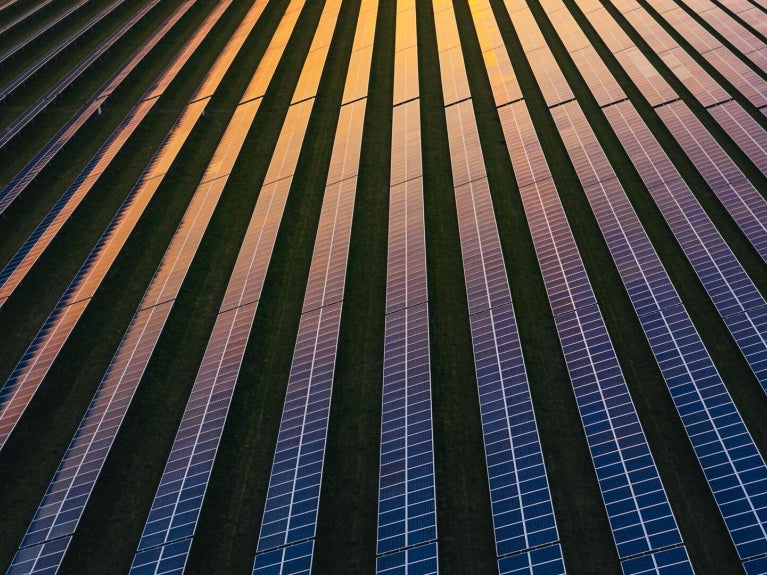BLM Proposes Updated Plan To Streamline Solar Development in the West

The U.S. Bureau of Land Management (BLM) announced on January 17, 2024, the publication of its draft Programmatic Environmental Impact Statement (PEIS) to help streamline and accelerate utility-scale solar energy development on public lands throughout the West.
The draft PEIS is the product of BLM's year-long outreach and public engagement effort to understand the needs and priorities for solar development on public lands across 11 western states.
BLM seeks to guide applications for development of solar rights-of-way (ROWs) away from public lands with a known high potential for resource conflict while also maintaining sufficient flexibility to adjust for site-specific resource concerns. BLM's preferred strategy involves prioritizing lands for solar that have minimal natural resource constraints (e.g., avoiding habitats for sensitive species), less than 10% slope, and are located within 10 miles of existing or planned transmission lines. Under proposed land use plan amendments analyzed in the draft PEIS, lands that meet these constraints would be designated "solar application areas" open for development.
Background
In December 2022, U.S. Secretary of the Interior Deb Haaland announced that BLM will develop an updated PEIS to guide solar energy development on public lands throughout the West. The draft PEIS analyzes proposals to replace the existing Western Solar Plan (finalized in 2012), which covered land management plans in six western states—Arizona, California, Colorado, Nevada, New Mexico, and Utah—and provided a comprehensive solar energy program applicable to all utility-scale solar energy development on BLM-administered lands.
According to BLM, an update to the Western Solar Plan is necessary "to improve and expand the BLM's utility-scale solar energy planning in response to national priorities and goals for renewable energy development and changes in solar technologies since 2012." The draft PEIS reflects increased demand for solar—particularly photovoltaic (PV) technology—on public lands through 2045, including a growing interest in northern latitudes beyond the original six states in the 2012 Western Solar Plan.
The draft PEIS also aligns with the Biden-Harris administration's goal to increase renewable energy development on public lands under Executive Order 14008, which directed the secretary to streamline solar permitting on public lands. BLM's effort also responds to the Energy Act of 2020, which directed the U.S. Department of Interior to "seek to issue permits that, in total, authorize production of not less than 25 gigawatts of electricity from wind, solar, and geothermal energy projects by not later than 2025."
Scope and Applicability
The draft PEIS contains an overarching analysis of proposed amendments to BLM's area-specific resource management plans (RMPs) to guide solar development. The analysis considers the environmental, cultural, and economic impacts of utility-scale solar, as well as the impacts of supporting facilities (e.g., transmission infrastructure). However, even though supporting facilities are considered, BLM clarifies that the new land use decisions analyzed by the draft PEIS would only apply to solar generation facilities. Management decisions for supporting facilities will continue to be evaluated pursuant to existing land use plans and policies.
The proposed land use amendments in the draft PEIS would not eliminate the need for project-specific environmental review. Although the draft PEIS identifies lands available for solar development, this does not mean that BLM has affirmatively determined that such lands are suitable for development. Rather, programmatic-level identification of the lands helps guide developers to lands that "BLM anticipates having fewer issues with critical resources or other critical uses." Each development application would still need to be analyzed on a project-specific basis in accordance with the National Environmental Policy Act (NEPA) and other applicable laws. The BLM may tier to relevant analysis in a final PEIS but "will consider site-specific impacts of individual project applications prior to any agency decision [to grant a ROW for development of public land]."
BLM also proposes to change the definition of "utility-scale" solar—which limits the types of projects that may apply—to include generation facilities with a nameplate capacity of five megawatts (MW) or more. Currently, under the Western Solar Plan, only facilities of 20 MW or more satisfy this definition. BLM says this change is consistent with industry projections and signals responsiveness to changing market dynamics. BLM also recognizes the increasing prevalence of solar paired with battery storage and the land use analysis in the draft PEIS assumes an additional one acre/MW to account for the footprint of on-site storage facilities.
Expanded Study Area
The draft PEIS proposes an expanded 11-state study area that covers the six states included in the Western Solar Plan—Arizona, California, Colorado, Nevada, New Mexico, and Utah—plus Idaho, Montana, Oregon, Washington, and Wyoming. The study area would apply to all BLM-managed lands in these states (approximately 162 million acres combined), except for lands covered by the Desert Renewable Energy Conservation Plan (DRECP) in Southern California. A map of the proposed study area with an overlay of lands subject to BLM jurisdiction through the draft PEIS (BLM decision area) is below.

The DRECP, issued in 2016, is a landscape-scale planning effort covering approximately 27 million acres in Southern California that was developed to advance conservation goals, meet Endangered Species Act (ESA) and Federal Land Policy and Management Act (FLPMA) requirements, and facilitate the timely and streamlined permitting of renewable energy projects. BLM decided to exclude the DRECP from the draft PEIS study area because it believes the DRECP amendments continue to support "an acceptable integration of conservation and renewable energy opportunities within its decision area boundary."
Conversely, BLM proposes to include lands within the Restoration Design Energy Project (RDEP)—a 2013 BLM planning effort in Arizona—in the draft PEIS study area, which would result in elimination of the existing Renewable Energy Development Area (REDA) land use designations within its footprint. According to BLM, this change will better align lands available for solar within the REDAs with the updated BLM procedures and help ensure consistency in land use allocations across Western states.
Transmission-Focused Approach
The draft PEIS examines six alternatives (five "action" alternatives and one "no action" alternative) to identify BLM-administered lands that should be available or excluded from utility-scale solar development.[1] Of the six alternatives, BLM identifies Alternative #3 (transmission proximity) as the preferred option that provides sufficient land and generating capacity to support utility-scale solar development in the 11-state area through 2045. The various alternatives are described as follows:
- Alternative #1: resource only. Alternative #1 would exclude from solar development areas of known cultural or environmental importance based on application of specific "resource-based exclusion criteria." The remaining BLM-administered land (approx. 55 million acres) would be available for utility-scale solar.
- Alternative #2: resource and slope. Alternative #2 would exclude land with greater than 10% slope in addition to the resource-based exclusion criteria. The remaining BLM-administered land (approx. 36 million acres) would be available for utility-scale solar. BLM notes that the decision to add a slope exclusion is environmental, not technology-based. During the scoping process, BLM received extensive comments supporting retention of a slope exclusion criterion (the Western Solar Plan included a 5% slope exclusion) to avoid unnecessary degradation and wildlife/visual impacts.
- Alternative #3: transmission proximity (preferred). In addition to the slope- and resource-based exclusion criteria, Alternative #3 would limit solar development to areas within 10 miles on both sides of existing and planned transmission lines with capacities of 100 kV or greater and/or areas proximate to the centerline (i.e., within 10 miles) of most federally designated (Section 368) energy corridors. This alternative responds to the extensive public comment that project viability depends on proximity to transmission resources. BLM data also shows that many existing solar projects are currently sited within three miles of transmission infrastructure. If new transmission resources (i.e., not currently planned) become available, BLM would have the option to amend the applicable RMP and open additional lands. Alternative #3 would make approximately 22 million acres of BLM-administered land available for utility-scale solar.
- Alternative #4: previously disturbed lands. In Alternative #4, utility-scale solar development would be limited to previously disturbed areas that have diminished resource integrity. The slope and resource-based exclusion criteria would also apply. The intent of Alternative #4 is to limit impacts associated with utility-scale solar energy projects on undisturbed lands. Alternative #4 would make approximately 11 million acres of BLM-administered land available for utility-scale solar.
- Alternative #5: previously disturbed lands and transmission. Alternative #5 combines the restrictions of the prior alternatives by limiting utility-scale solar development to previously disturbed lands in close proximity to transmission infrastructure (in addition to the resource-based and slope exclusion criteria). BLM notes that while Alternative #5 also prioritizes proximity to transmission and provides sufficient land to meet 2045 projections, Alternative #3 is preferred because it provides a "larger margin of siting flexibility to avoid important resources" through site-specific environmental review.
Although BLM identified Alternative #3 as preferred, the agency notes that it could ultimately adopt a combination of alternatives. Selected alternatives could also vary by geographic region.
Simplified Land Use Allocations
The Western Solar Plan identified three categories of land (land use allocations) for solar development: solar energy zones (SEZ), which are areas of land prioritized for development; areas of land that should be excluded from development; and "variance" areas, or areas of land that are neither excluded nor prioritized but could be developed through other specific, more restrictive procedures. In response to extensive comments that BLM should either consider the lands "open" or "closed" to solar and not seek more precise locations (like SEZs), the draft PEIS proposes a simplified two-category system. Across all alternatives, land is classified as either "solar application areas" or "excluded." Variance areas and related process for variances from the Western Solar Plan requirements would be eliminated.[2] BLM notes that this change also aligns with practical observations since 2012. Despite the intent to focus solar in SEZs, BLM has received and approved the same number of utility-scale solar energy development applications in areas identified as variance areas as it has within SEZs. By simplifying the land use allocations, BLM aims to reduce redundancy and achieve a "higher likelihood of alignment with the BLM's multiple use and sustained yield mission than under the Western Solar Plan."
Updated Exclusion Criteria
Like the Western Solar Plan, the draft PEIS analyzes resource-based exclusion criteria that BLM would employ to avoid lands with known cultural or environmental significance.[3] In the draft PEIS, BLM proposes two main changes to the resource-based exclusion criteria. First, it proposes eliminating the assumption that solar cannot be developed on land with greater than 5% slope. BLM proposes to increase the percentage to 10% and instead wrap this parameter into the alternatives analysis, as described above (i.e., for Alternatives #2-5, solar application areas would exclude land with slope greater than 10%). Second, BLM proposes to eliminate the exclusion that restricted development to land with solar insolation levels greater than 6.5 kWh/m2/day. BLM made this change in response to feedback that solar technology has improved since 2012, and it no longer makes sense to limit by solar radiation potential.
Prescriptive Design Features
The draft PEIS analyzes updates to the programmatic design features from the Western Solar Plan. Solar projects within the 11-state study area of the draft PEIS would have to incorporate specific design features to avoid, minimize, and/or compensate for adverse impacts and all design features would be required if applicable within the location of the solar facility.[4] Measures not designated as "required" (e.g., not within the jurisdiction of BLM) are available for the developer's consideration but not part of the programmatic design features. Each required design feature now also includes the designation of the party responsible for implementation, which is usually the project developer, but in some cases can be BLM. By making the design features more specific, BLM seeks to improve clarity, which may help reduce the magnitude of impacts. Developers should review the proposed design features carefully and provide input to BLM regarding their feasibility.
Next Steps
BLM published the Notice of Availability in the Federal Register on Friday, January 19, 2024, which kicks off the formal 90-day comment period for the draft PEIS and allows interested parties to submit written feedback or participate in virtual or in-person scoping meetings. The comment period closes on April 18, 2024. Following the comment period, BLM will develop a final PEIS and Record of Decision amending BLM land use plans.
Endnotes
[1] See Executive Summary (pages ES 12–16, 21) of the Draft PEIS for maps displaying the amount of land available for solar application under each alternative.
[2] The land encompassed by SEZs, as identified by the Western Solar Plan, would generally be retained under the new "solar application area" land use allocation. BLM also notes that although the variance process would be eliminated, BLM would continue to perform a similar screening analysis when processing solar applications in accordance with existing regulations, policy, and procedures to identify "areas of special concern" prior to initiating the NEPA analysis. See Appendix H of Draft PEIS for maps identifying areas of special concern.
[3] BLM clarifies that lands are excluded if they satisfy any one of the exclusion criteria regardless of whether they are shown to be part of exclusion areas mapped based on GIS data.
[4] The proposed design features are presented in Appendix B of the Draft PEIS by resource type and by project phase (i.e., general; site characterization, siting, design, and construction; operations and maintenance; and decommissioning/reclamation).
© 2024 Perkins Coie LLP



